Camille A. Brown’s Inspirational Moves and Message
Camille A. Brown & Dancers mesmerized audiences and schoolchildren across Southeast Michigan during their January residency.
From workshops in K-12 schools to community dance events, a sold-out School Day Performance, and the UMS debut of their powerful work, ink, here are seven of our favorite moments:
1. Teaching Artist Workshops
UMS Teaching Artists worked with Scarlett Middle School students and other local schools to learn about Camille Brown’s unique choreography and movement, in preparation for their upcoming School Day Performance. To bring the lesson full circle, Teaching Artists returned to each school to lead post-performance workshops.

2. Learning History through Dance
Company member Catherine Foster led a Community Movement Workshop in Detroit’s Charles H. Wright Museum of African American History, taking participants on a journey of dance history. From a call-and-response warm-up to the “Lindy Hop”, swipe through our Instagram post to watch the class unfold!
View this post on Instagram
3. Master Class at U-M
While on campus, company member Juel D. Lane led a creative and thought-provoking master class with University of Michigan dance students.

4. A Cool School Day Performance
More than 1,200 K-12 students from 13 area schools (including every Scarlett Middle School student) arrived at the Power Center for a sold-out School Day Performance. The Company’s mix of cool moves, hip-hop, rhythm, and visual storytelling drew countless oohs and aahs from the young crowd!

5. A Special Q & A
After the performance, students from Scarlett Middle School met with the company. Camille shared how she found the power to express her voice through dance. She encouraged students to be resilient and stay close to their community of support, especially in the face of criticism, remarking, “If you don’t believe in who you are and what you’re doing, who will?”

6. You Can Dance!
Camille A. Brown & Dancers company members Timothy L. Edwards and Maleek Washington invited local dancers of all ages and levels to explore movement with them at the Ann Arbor Y.

7. A Poignant Closing
“Energizing, thought-provoking, and simply beautiful” is how one audience member shared his appreciation for ink, the final installation of the company’s trilogy of stories of Black identity. Explosive choreography and the rhythmic interplay between the musicians and dancers left Saturday night’s audience enthralled and wanting more.
A lively Q & A after the performance shed light on the symbolism and meaning behind the theatrical choreography — all intended to expand the narrative of hopes, dreams, relationships, and community beyond entrenched stereotypes.
—
Our sincerest appreciation to Camille A. Brown & Dancers for a beautiful week of movement and creative inspiration. Follow @CamilleABrown on Instagram to keep up with the company’s work on and off the stage on Instagram.
21st Century Intern Travelogue: Kandis Terry
“My summer experience as one of four UMS interns is one that I cannot put into words. This opportunity not only gave me the chance to grow as a student, but also gave me every tool I didn’t know I needed to heal as an artist.”
 Kandis Terry spent the summer of 2018 in New York City with Camille A. Brown & Dancers (CABD) as part of her 21st Century Internship — a program in collaboration with UMS and the University of Michigan School of Music, Theatre & Dance.
Kandis Terry spent the summer of 2018 in New York City with Camille A. Brown & Dancers (CABD) as part of her 21st Century Internship — a program in collaboration with UMS and the University of Michigan School of Music, Theatre & Dance.
The best part of my time as a 21st Century Intern was that I was able to surround myself with all types of artists from diverse cultures and ancestral backgrounds. I realize that I have a voice and that my quality of movement matters. I saw the possibilities and wonders that artistic “creation”—specifically that of Black Women—can do. Through Camille’s artistry and leadership, and with her unique administrative team, I have been able to make many new professional connections and forge relationships. Here are two of my favorite experiences from my summer:
Dance/USA Annual Conference
 One of the most memorable experiences from my internship was attending the extraordinary Dance/USA annual conference in Los Angeles. There I engaged in a delightful conversation with leaders representing many demographics about social stature, gender, and race within movement and culture—in particular, Black men, women, boys, and girls. Although these topics are not always given the spotlight or recognition in what is known today as a common and adequate professionalism in the art of dance, Camille’s work gives voice to social issues that have been presumably swept under the rug for a long time.
One of the most memorable experiences from my internship was attending the extraordinary Dance/USA annual conference in Los Angeles. There I engaged in a delightful conversation with leaders representing many demographics about social stature, gender, and race within movement and culture—in particular, Black men, women, boys, and girls. Although these topics are not always given the spotlight or recognition in what is known today as a common and adequate professionalism in the art of dance, Camille’s work gives voice to social issues that have been presumably swept under the rug for a long time.
Gibney Dance Center Educational Panel

Camille A. Brown, Kandis Terry, Indira Goodwine
Much of my time in New York was surrounded around mental health awareness. I had the pleasure of working with CABD’s Managing Director Indira Goodwine, whose sense of positive morale and work ethic I really looked up to. She taught me to grow and continue be the best version of myself, or at least strive to be.
On my first day of my internship, I observed her talk as part of a three-member panel at the Gibney Dance Choreographic Center, which represented a perfect balance of poise, eloquence, and artistic measure. Each artist spoke to their unique experiences as a professional dancer up to this point in their respective careers.
Indira was the only woman on panel, and encouraged all of the women in the room to pursue a successful career in the arts profession. She spoke about how incorporating mental wellness in your work field or place environment contributes to one’s success and overall happiness in life, with some wise words on how to conclude each day:
- “We are in charge of what, when, and how we make both sense of and success with the findings we collect from our artistic research.”
- “What you have to offer is more than you know.”
- “Language matters.”
CABD dancer Maleek Washington was also on the panel, and offered great advice to those in attendance:
- Know who you are as a person and who you are as a dancer.
- Instagram gives you instant access to publicity at your fingertips.
- ‘Word of Mouth’ is important.
- Go see shows, take class!
- Put in hard work now.

It was a great way to start my internship! From that point on I knew it was my job and my responsibility to capture and embrace all of the tasks and opportunities presented to me over these next upcoming summer months.
—
While at U-M, my educational experience has been enriched but challenging. This internship saved me. It showed me that many artists of color struggle with mental wellness. In response and efforts to address this epidemic, we must be resilient and push forward with our talents and passion for creativity.
At times I have felt lost, but my 21st Century Internship experience, in its entirety, was an affirmation for me, and the beginning to my course and journey towards healing and setting new goals.

UMS Night School Session 5 Recap: Reflection and Graduation
Please note: This post is a part of series about the free and open to the public UMS Night School. UMS Night School: Constructing Identity runs January 18-February 15, 2016.
On Monday, February 15, I attended our last UMS Night School session of the season. We chatted about the 2016 edition of UMS Night School, and our special guest speaker was Jennifer Harge, Artistic Director of Harge Dance Stories.
We began class with a different spin on the usual movement activity. Harge asked us to create two movements: one that reflected what others think of us, and another that reflected our self-image. Harge then asked us to draw upon a childhood memory to act it out. The purpose of this activity was to get us thinking about the difference between performing the movement as a child and performing it as an adult. This led into a discussion of Camille A. Brown’s Black Girl–Linguistic Play, which was performed this past Saturday, February 13 at 8pm in the Power Center.
We talked about how Brown’s work challenged the perception of dance. Harge explained that the work challenged the dancers in the show because they had to let go of everything they had been trained to do as dancers; they had to become naïve in order to successfully portray Brown’s experience as a young black girl.
One Night School student said that Brown’s work made him think of the old Peanuts Cartoons–the characters are all children, yet they each have their own idiosyncrasies as adults do.
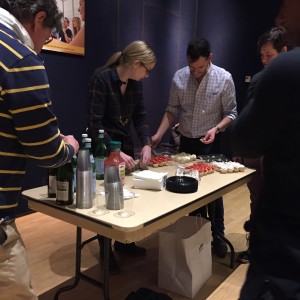 We ended by celebrating with a raffle, a perfect attendance award, and cupcakes!
We ended by celebrating with a raffle, a perfect attendance award, and cupcakes!
I’ve learned a lot about constructing identity as an artist and an audience member, and I’ve been introduced to several new and exciting ideas. It’s also been nice to step away from school and engage with community members from around the area. In the future, I strongly suggest that you experience at least one of these classes; the worst thing that could possibly happen by trying it just once is that you won’t win the perfect attendance award ;)!
Details about next season’s UMS Night School will be available in Summer 2016.
Behind the Scenes: Dance Activities
Camille A. Brown & Dancers performed Black Girl – Linguistic Play on February 13, 2016, and the dancers also participated in various community activities including a free Breakfast Download post-performance discussion and all-levels You Can Dance workshop. UMS also hosted a panel celebrating 25 years of the Dance Series at UMS.
What some of the participants thought about their experiences:
Photo moments from the weekend:
Quotes from the weekend:
“I saw myself in this play. The way the dancers expressed themselves in each scene seemed like flashes of my own life.”
-Christina DeBlanchi, Black Girl: Linguistic Play audience member
“Being in college means I have to be an adult who is focused on reading and writing. It was really fun to see something equally, or even more important, happening on stage. It brought me joy. And these experiences give me the opportunity to learn more by exploring my self, instead of reading about others.”
-Alexis Lesperance, U-M Residential College student
Interested in more? Learn about our community education programs.
UMS Night School: Constructing Identity Together – Session 4 Recap
Please note: This post is a part of series about the free and open to the public UMS Night School. UMS Night School: Constructing Identity runs January 18-February 15, 2016.
This past Monday, I attended my second UMS Night School session. For this week’s session, we discussed this past weekend’s performances by Tanya Tagaq and Taylor Mac.
The discussion focused on how Taylor Mac and Tanya Tagaq made their performances accessible and relatable to audiences; some of the UMS Night School participants noted that Taylor and Tanya’s performances were “welcoming” and “inviting.” Talk about constructing identity together! These two artists really went above and beyond in engaging their audiences, whether it was physically (like Taylor Mac) or emotionally (like Tanya Tagaq), or both!
We then moved into a discussion of upcoming performance of Camille A. Brown’s Black Girl–Linguistic Play, occurring this Saturday, February 13, 2016 at 8 pm in the Power Center. This time around, the discussion was lead by guest speakers Robin Wilson (Associate Professor of Dance) and three University of Michigan students in the School of Dance: Michael Parmelee, DeeDee Fattore, and Selena Moeljadi, all of whom had the experience of being involved in Camille A. Brown’s City of Rain.
Camille A. Brown’s City of Rain, performed by the Mason Gross School of the Arts.
While the video above does not feature our awesomely-talented guest speakers, it does feature some of the emotion that our speakers said they’ve learned to channel in their performance of City of Rain, which was featured in the University of Michigan Dance Department’s most recent showcase, Momentum, which ran from February 4-7, 2016.
Robin Wilson shared her experience of what it was like to be the Rehearsal Director for City of Rain, while the students shared their experience of being in the midst of City of Rain.
What did you learn?
Jim asked the guest speakers what they learned from their experiences of City of Rain. Students mentioned “grief” and “sadness” in the physical movements that they experienced. They had to dig deep to successfully understand those (and other) emotions in the choreography. The students could’ve simply emulated the emotion that Camille A. Brown suggested, however, this would be similar to an instrumentalist emulating the emotion that a composer intended in a piece, or similar to an actor emulating emotions onstage. Sure, that might look and sound fine and dandy, but it would be different from the real thing. The real thing is when students draw upon their own grief, their own sadness, their own emotion to make Brown’s choreography much more powerful.
Robin Wilson, as Rehearsal Director, assisted in this process. She summed it up nicely: “We want a cake with the rum soaked through [not a cake with frosting on top]!”
Student DeeDee Fattore said that in her research she has found that she really loves that Brown’s work is so relatable; anybody – dancer or audience member – can relate to the movements and emotions in her work. Fattore says this is something that she would like to be able to do in her own work as a choreographer.
Black Girl – Linguistic Play
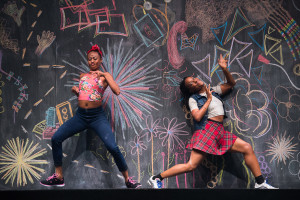 We shifted gears toward the end of the class to talk about Camille A. Brown’s Black Girl – Linguistic Play, which will be performed this Saturday, February 13, 2016 at 8 pm in the Power Center.
We shifted gears toward the end of the class to talk about Camille A. Brown’s Black Girl – Linguistic Play, which will be performed this Saturday, February 13, 2016 at 8 pm in the Power Center.
Asked what “Black Girl” really means, Wilson pointed out that it’s an important specificity. “Black” in this context is vernacular, being unapologetically oneself, and also implies that the work is perhaps intentionally less refined than and less conforming to the African American cultural identity. “Girl” in this context is associated with sass, playfulness, being yourself. Camille uses the title “Black Girl” to hone in on the identity and experience of being a “Black Girl.” Tickets to the performance are still available.
This session really pumped me up for the performance this weekend, and I walked out of the Alumni Center feeling inspired and full of new perspectives and insights.
I’m telling you, if you are looking to expand your horizons, these classes are amazing! There is only one session left, so join us next Monday, February 15, at 7 pm in the Alumni Center for Reflection and Graduation.
Explore: Connections Between UMS and U-M Museum of Art
Visual and performing arts have a close relationship. We asked our partners and friends at UMMA (U-M Museum of Art) to link performances on the UMS season with visual art works that are part of the museum’s permanent collection.
Related performance: Tanya Tagaq in concert with Nanook of the North
February 6, 2016
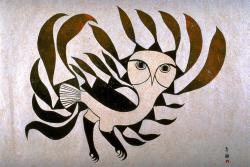 Artwork: Kenojuak Ashevak (Canadian, 1927-2013). Sun Owl, 1963. Stonecut print on paper. Gift of Mr. and Mrs. Eugene B. Power, 1964/2.103
Artwork: Kenojuak Ashevak (Canadian, 1927-2013). Sun Owl, 1963. Stonecut print on paper. Gift of Mr. and Mrs. Eugene B. Power, 1964/2.103
Like Tanya Tagaq, Kenojuak Ashevak was from Nunavut and her art was inspired by her Inuit experience. She often depicted animals from the Arctic such as this owl, but, also like Tagaq, she relies on her creativity and imagination. Ashevak explained that she drew as she thought, and so she produced spontaneous and improvisatory images.
Related performance: Camille A. Brown & Dancers: Black Girl — A Linguistic Play
February 13, 2016
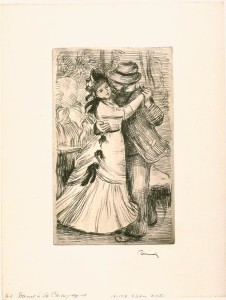 Artwork: Pierre Auguste Renoir (French, 1841-1919). Dance in the Country, c. 1890
Artwork: Pierre Auguste Renoir (French, 1841-1919). Dance in the Country, c. 1890
Soft-ground etching on paper. Museum Purchase, 1959/1.102
In Renoir’s beloved image of country dance we see an earlier century’s ritual of recreation. Although more restrained than contemporary dance, it represents social dance, one of the inspirations for choreographer Camille Brown’s work.
Related performance: Nufonia Must Fall
March 11-12, 2016
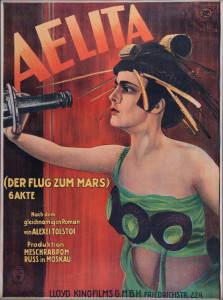 Artwork: P. Grasnick (n.d.). Aelita, 1924
Artwork: P. Grasnick (n.d.). Aelita, 1924
Lithograph on buff woven paper, laid down on canvas. Gift of James T. Van Loo, 2013/2.233
This poster is for the movie Aelita, which is often called the first Soviet science fiction film, created during the sometimes hope-filled beginnings of the Soviet Union. A mysterious radio message is beamed around the world, and among the engineers who receive it are Los, the hero of the film. Aelita is the daughter of Tuskub, the ruler of a totalitarian state on Mars. With a telescope, Aelita is able to watch Los who obsesses about being watched by her. He builds a spaceship and travels to Mars where he is thrown in prison, begins a proletarian uprising and experiences the confusion of reality and fantasy. While Nufonia Must Fall is no sci-fi film, it is based on a graphic novel of the same title, and viewers might find similarities between the genres.
Related performance: Gil Shaham Bach Six Solos
with original films by David Michalek
March 26, 2016
 Artwork: Shitao (Shih-t’ao; Chinese, 1642-1707) Ode on a Wanli-era Imperial Brush Ink on paper, 1705. Museum purchase made possible by the Margaret Watson Parker Art Collection Fund, 1965/2.75.
Artwork: Shitao (Shih-t’ao; Chinese, 1642-1707) Ode on a Wanli-era Imperial Brush Ink on paper, 1705. Museum purchase made possible by the Margaret Watson Parker Art Collection Fund, 1965/2.75.
Taking an honored and beloved corpus of music from the past, Gil Shaham transforms its familiar beauty into a fresh, contemporary work of art. Similarly, Shitao receives a beautiful gift, a porcelain-handled calligraphy brush, from an earlier generation and uses it to write a poem and create a calligraphic masterpiece. The era and form are new but the inspiration is classic.
Related performance: Mariachi Vargas de Tecalitlán
April 1, 2016
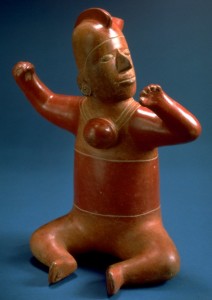 Artwork: Artist Unknown, Mexican, Colima Culture Seated Figure, c. 700 Terracotta Museum purchase made possible by a gift from Helmut Stern, 1983/1.355Artist Unknown, Mexican, Colima CultureSeated Figure, c. 700TerracottaMuseum purchase made possible by a gift from Helmut Stern, 1983/1.355
Artwork: Artist Unknown, Mexican, Colima Culture Seated Figure, c. 700 Terracotta Museum purchase made possible by a gift from Helmut Stern, 1983/1.355Artist Unknown, Mexican, Colima CultureSeated Figure, c. 700TerracottaMuseum purchase made possible by a gift from Helmut Stern, 1983/1.355
This lovely terracotta seated figure is an example of the native arts and culture celebrated by Mexican visual and musical artists. Mariachi Vargas de Tecalitlán transform a regional folk music into a world-class art form.
Related performance: Zafir: Musical Winds from North Africa to Andalucia
April 15, 2016
 Artwork: Artist Unknown, North Africa Qur’an manuscript leaf in Maghribi script, 13th century Ink, red ochre, paper Museum Purchase, 1959/1.146
Artwork: Artist Unknown, North Africa Qur’an manuscript leaf in Maghribi script, 13th century Ink, red ochre, paper Museum Purchase, 1959/1.146
For Muslims, Arabic script, representing the language of the Qur’an, is a thing of sublime beauty. This page is written in a script called Maghribi, a variation of the earlier, angular, Kufic script. Maghribi features sweeping curves that loop across the page and was developed in North Africa and Spain. This Qur’an page combines traditions of the Middle East, Spain and North Africa as does the music of Simon Shaheen and Zafir.
Interested in more? Visit the U-M Museum of Art today.
Dance is Alive and Well and Living in Detroit

Four dancers from Epiphany Dance perform in Harmonie Park during DDCF.
“If you’re going to do a triple, it’s got to be fast.” The spacious stage of the Detroit Music Hall stage looked skeletal as thirteen young women learned a complex piece of jazz choreography. Well, thirteen young women and one virtuosic young man, no more than eleven years old, whose pirouettes were right on par with the rest of the class. The sounds of Cher and Chaka Khan echoed off of the art deco ceiling of the theater before sinking into the rich red velvet of the seats. Dancers pulsated with energy, hitting each beat meticulously for just a moment before leaping into the next one.
My weekend at Detroit Dance City Festival was full of moments like that. The Festival, in its third year during Summer 2015, is the brainchild of ARTLAB J founder and dance innovator Joori Jung. Originally from Seoul, Korea, she moved to Detroit and, in two short years, took it upon herself to make Detroit more open to the international dance community. The weekend of the Detroit Dance City Festival was a conglomerate of art makers, performers, and the business-minded people making dance a sustainable practice. Some attendees did all three.
Mind you, I was very much a fly on the wall here. I Irish-danced as a girl, but I had hung up the hard shoes a while ago and was perfectly content with observing this perfectly postured world as it spun around me. Workshops like the one in the Music Hall were happening every day and ranged in focus from jazz to modern to West African. I watched many of them, but my personal favorite was taught by Beatrice Capote, a dancer in Camille A. Brown and Dancers company. Once the class began, the West African drum beat hardly ever stopped. Beatrice built small gesture upon gesture, introducing this unique style of dance to a large group of students foreign to the form, until the room was full of stomping feet and flailing arms, all somehow keeping time to the impossibly quick rhythm. One of the most important elements of this style, Beatrice stressed, was connection. West African dance is a form of communication, a way to celebrate the extraordinary elements of the ordinary day. Certainly this was true of the workshop. What began as a group of serious, focused young artists melted into a crowd of smiling young people, improvising, applauding, and laughing.
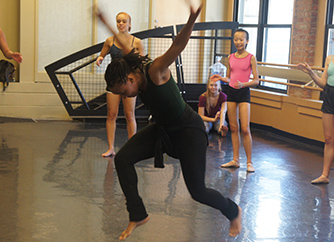
Beatrice Capote leads an improv session during her workshop.
That evening, Beatrice would perform a portion of Black Girl — A Linguistic Play with her fellow company members from Camille A. Brown and Dancers at the DDCF Gala, the cornerstone of the weekend. To begin the conversation on some of the elements of this work, she asked her workshop participants what they thought about when they heard the words “black girl.” There was an awkward silence, and I admit I was glad I didn’t have to come up with a response; there is no right answer to that question, but there are definitely wrong ones, and everyone treaded carefully with choice of words. Beatrice had obviously asked this question before and was familiar with this reaction. In fact, she said that it was this tension surrounding the concept of “black girl” identity that prompted Camille A. Brown and her dancers to create this work. Using what Beatrice referred to as “vernacular dance,” the company has referenced playground interactions, sibling bickering, handshakes, and pop culture (if you look closely you can spot Beyoncé’s infamous Single Ladies chug) to elevate the experience of young black women. The performance was moving, and the piece in its final state, coming to UMS in February, will not be one to miss.
The weekend was full of performances. I spent my late afternoons in the charming Harmonie Park across from the bustling Carr Center watching local dance troupes perform in beautiful sunshine. One group of four young girls from Epiphany Dance, a Detroit-based company, stood out in particular. Clad in bright yellows and greens, they glided across the stage in beautifully executed choreography. As I watched I couldn’t help but connect their passion with what is at the heart of Camille A. Brown’s work; these girls, sharing what they love without reserve or restraint, seemed to me to encompass what Camille might seek to capture in her art. Many of these outdoor performances felt just as joyful. I loved the way the brief season of Michigan warmth was animated through hip-hop, lyrical, rhythmic gymnastics, even Polynesian dance.
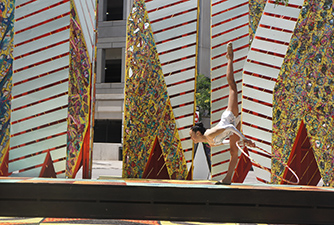
An exciting rhythmic gymnastic performance in Harmonie Park.
In the evenings, the art makers shined at the Choreographer Showcases. The first two nights of the Festival featured over twenty pieces from choreographers from across the country. I, like many, am a bit of a novice to the current trends in dance, and was pleasantly surprised to discover that dance is capable of much more than I initially assumed. I learned that, contrary to popular belief, dance does not need music. I saw multiple pieces in partial or total silence, pieces that kept me completely engaged. Dance can also use video, voice, and live music to elevate movement. One of my favorites used traditional mime techniques melded to modern hip hop to create a metaphor for immigrating to the states. I was mesmerized. As one participant told me, “The modern movement blew open the possibilities of dance, and we’ve been trying to figure out to do with it ever since.”
While performance was certainly the focus of the Festival, the weekend had an undercurrent of stimulating conversations about sustaining dance in Detroit and strengthening the international dance community. Through a series of panel discussions, I learned about the numerous organizations in Southeast Michigan who are dedicated to helping dance and those who create it thrive. Shivangee Pandya represented Creative Many, a group that advocates for the development of professional artists in Michigan. They provide legal aid, educate on the fundamentals of becoming a non-profit, and assist in contract work. They recognize that being a professional artist means running a business, and their dedication to the establishment of solid foundations for these artists shows a profound respect the dignity of creative work. I had the chance to chat with Lynne Friman of Culturesource and IXITI, a website that posts any and all creative performances and events happening in and around Detroit. With a shock of purple and blue hair and a big smile, she was able to list at least three people in the Detroit arts scene that you must know, all within the first five minutes of my chatting with her. She, and many others in attendance, are living advocates for the growing number of dance, theater, and music artists in the area, and they’re dying to tell you about it.
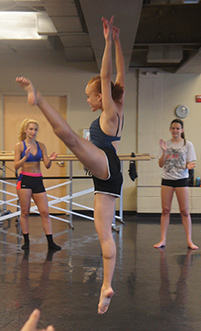
A dancer leaps during Beatrice’s workshop.
Equal parts celebration and exploration, the Detroit Dance City Festival never shied away from asking what dance is capable of. It wondered if it needed music, how it could be filmed, what props it could use, and who had access to it. The result was a real sense of community, a group of people who are willing to decide where dance can go from here. They will create the work, fund it, and find the audience, and they’ll enjoy the process just as much as the final product. It was exciting to be in on the secret that Detroit is rising fast on the global dance scale. Something tells me it won’t stay a secret for long.



